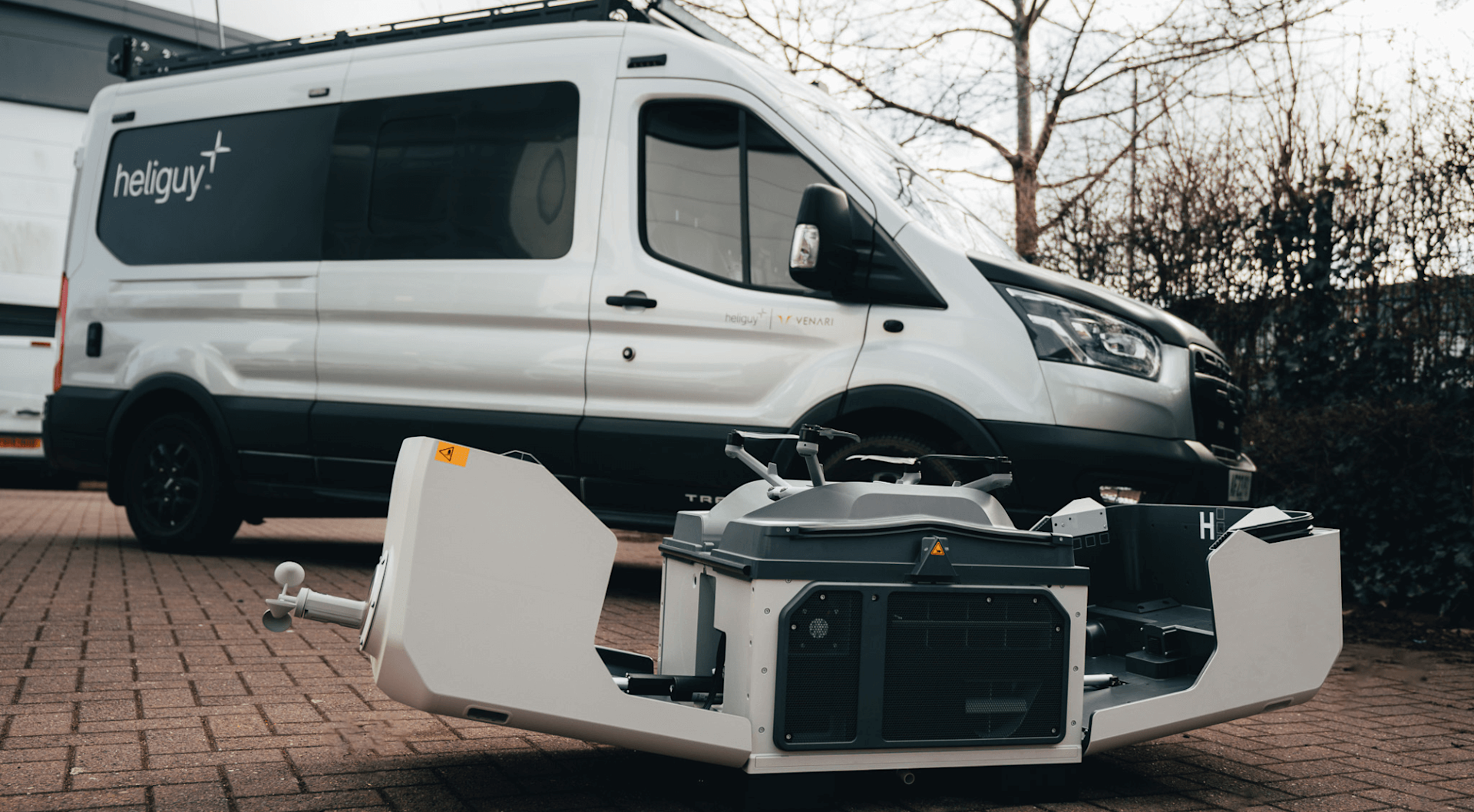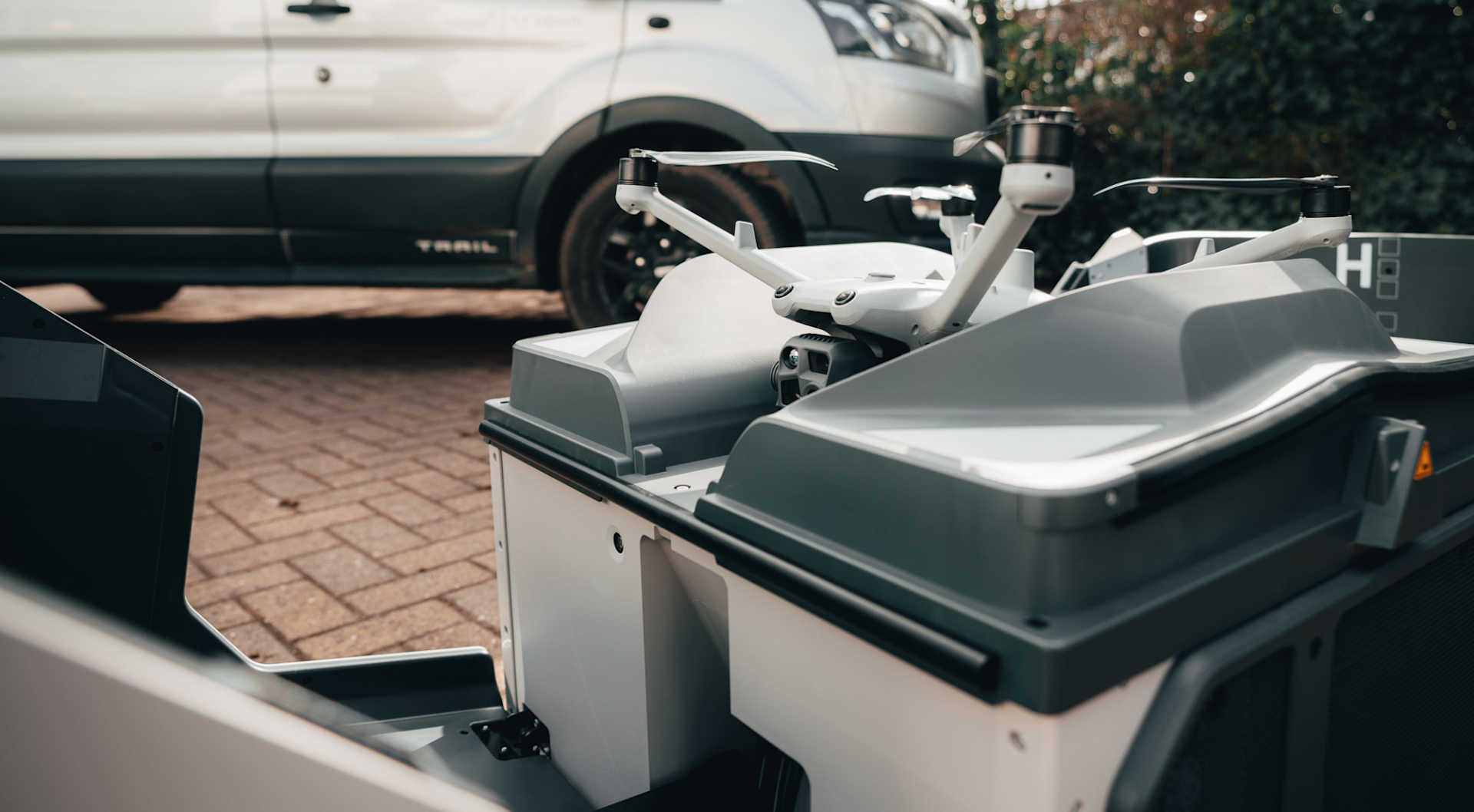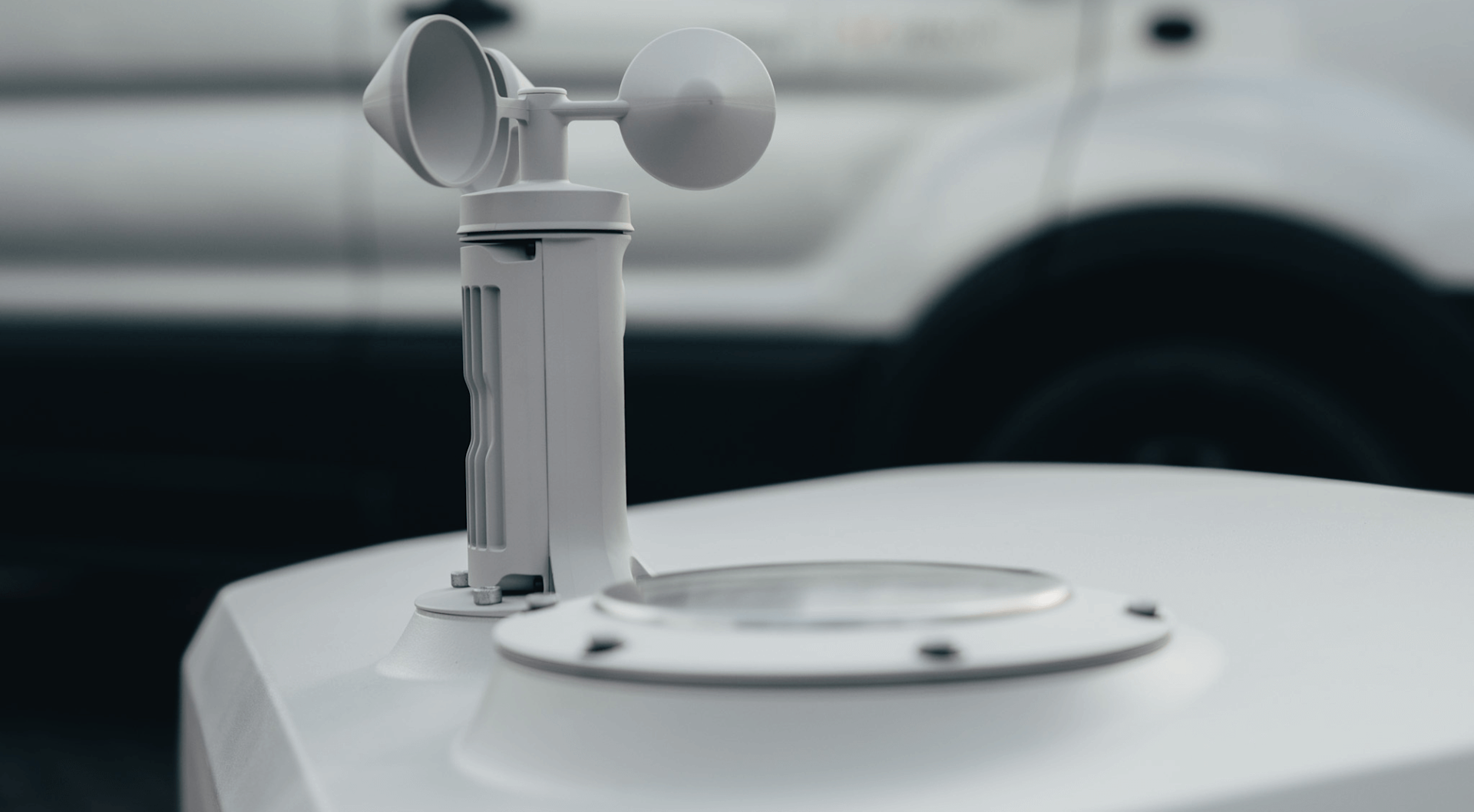
Training & Regulations
Published on 21 May 2025
James Willoughby
DJI Dock 3 and UK SORA: Unlock BVLOS drone-in-a-box deployment
In-depth look at the DJI Dock 3's BVLOS-ready features and how they can help mitigate ground and air risk for UK SORA applications.
DJI Dock 3 is a BVLOS-ready drone-in-a-box solution;
Benefit from features such as custom flight areas and geofencing, third-party parachute support, and ADS-B In capability;
The Dock ecosystem is packed with tech to mitigate air and ground risk, as part of UK SORA applications;
UK SORA offers a structured approach to managing risk and demonstrating safety;
heliguy™ has in-house regulatory specialists who can help you prepare UK SORA applications.
Safely navigating a complex flight route and never straying from its boundaries: This video shows how DJI Dock 3 obeys pre-defined rules during an automated mission.
It demonstrates perfectly how this drone-in-a-box is engineered to handle remote BVLOS flights.
And it is one of a number of mechanisms in place to empower such operations - from its drones' Flight Termination System module through to its ADS-B In capabilities.
Crucially, the Dock's BVLOS-ready architecture helps it meet key criteria for UK SORA applications - the process of gaining authorisation for beyond visual line of sight missions.
It's the perfect cocktail: Blending a progressive regulatory framework that offers a structured approach to managing risk and demonstrating safety, with a drone-in-a-box solution that provides a launchpad for BVLOS operations at scale.

In this article, we explore how the UK SORA framework supports and accelerates BVLOS authorisations, and how the DJI Dock 3 is engineered to meet the technical and procedural requirements set out in SORA.
Together, they present a compelling solution for operators looking to take their drone programmes to the next level, with confidence and compliance built in from the ground up.
And heliguy™ - who obtained approval to conduct BVLOS DJI Dock operations in Atypical Air Environments - has a UK SORA consultancy service to help you.
Understanding UK SORA
The UK SORA framework is based on the JARUS (Joint Authorities for Rulemaking on Unmanned Systems) SORA methodology, adapted by the UK CAA.
It is intended for operators applying for an Operational Authorisation in the Specific Category.
Key objectives of UK SORA include:
Assess the risk to people and property in the air and on the ground.
Define mitigation strategies at both strategic and tactical levels.
Classify the operation using SAIL (Specific Assurance and Integrity Level).
Prescribe levels of robustness for technical and operational safety objectives.
The UK CAA says that UK SORA's clear and standardised framework provides a transparent methodology for UAS risk assessment and will help to reduce the timescales involved in assessing applications and operators receiving authorisations.
For BVLOS flights, UK SORA is particularly crucial, as these operations generally fall into higher-risk categories and require comprehensive evidence of safety, reliability, and compliance.
And DJI Dock 3 - along with the DJI FlightHub 2 software suite - offers a plethora of mitigation strategies to tick multiple boxes in the SORA application process.
DJI Dock 3: Built for SORA-centric Compliance
DJI Dock 3 is more than a charging and launch hub - it is a fully-integrated, automated solution designed to support remote drone operations, especially BVLOS missions.

Such is the array of features of Dock and its associated aircraft, it has become DJI's first drone solution to receive a European C6 class-mark rating.
Essentially, DJI Dock 3 and its DJI Matrice 4D Series (M4D and M4TD) comply with C6 requirements, as defined in Part 17 of the Commission Delegated Regulated (EU) 2020/1058.
And on the Continent, a drone with a C6 marking can be used for BVLOS operations, specifically within a standard scenario called STS-02.
The table below demonstrates Dock 3's capabilities for meeting the criteria required for obtaining C6 certification.
Technical Standard Item | Requirement Description |
|---|---|
Flight Termination System (FTS) | Mandatory FTS with auto and manual activation, independent of flight control, ensuring safe descent and crash prevention. |
Geocaging | Define and enforce operational volume (OV and FG) boundaries; trigger alerts/FTS is breached. |
Maximum Takeoff Mass | Declared MTOM must be <25kg with ±2% tolerance. Manufacturer must document all configurations and validate combinations. |
Maximum Speed | Horizontal ground speed must not exceed 50m/s under any operational mode, considering wind effects. |
Controllability | Pass HQR assessments for manual/semi-auto/auto modes, ensuring safe transitions and workload management. |
Route planning | Enable 3D waypoint planning with automated path generation; alert if plans exceed flight envelope. |
Position, speed, altitude display | Real-time updates (1Hz) with graphical/coordinate displays; accuracy documented in user manual. |
C2 link monitoring | Monitor signal strength (4 levels: Strong/medium/weak/lost); provide visual/auditory/tactile alerts. |
Remote ID and serial number | Broadcast Remote ID via WiFi Beacon, 20 digit SN compliant with ANSI/CTA 2063-A standard. |
Lighting | Ensure visibility (120m range) with controllable and green identification lights; comply with colour/coverage specifications. |
While this applies to Europe, it does have tangible knock-on benefits for UK operations.
Primarily, it is a glowing endorsement of Dock 3's BVLOS-ready nature. The architecture is in place.
But it goes further.
In proposals to tweak UK regulation - announced on May 8, 2025 - the UK CAA wants to introduce UK-specific product marking for class-marked UAS, ie replacing the C0 label with UK0 and so forth. This will essentially be a like-for-like - bar a few minor amendments.
The UK CAA has also said that it wants to maintain the existing regulatory approach for C5/UK5 and C6/UK6 UAS intended for use in the Specific Category, given there may be use cases for these class-marked UAS in the future.
DJI Dock 3: Mitigations for Ground Risk and Air Risk for SORA applications
Central to UK SORA is how it assesses operational safety risk. As such, it considers two aspects:
Ground risk
Air risk
Ground and Air Risk have a knock-on impact: Setting your SAIL (Specific Assurance and Integrity Level) - which represents the overall risk of an operation.
Based on this, the matrix will spit out a series of Operational Safety Objectives (OSOs) - plus other requirements - that the operator needs to comply with before an Operational Authorisation is granted.
And DJI Dock 3 - along with FlightHub 2 - has several core components to mitigate Ground and Air risk.
Ground Risk
DJI Dock 3 has several features to mitigate Ground Risk, including:
Custom Flight Areas
Flight Termination System and geocaging
Obstacle data
Third-party parachute
Custom Flight Areas
DJI FlightHub allows you to create Custom Flight Areas to prevent the drone from flying into unrelated territory. This is done by applying task areas and GEO Zones.
And this video shows how this works in practice - demonstrating how the aircraft will not break out of the task area (green) or penetrate the red boundary (GEO Zone)...no matter how hard you try!
This geofencing mitigation helps to alleviate the containment aspect of a SORA application - ie, the drone is capable of staying within a defined operational volume.
Flight Termination System
The DJI M4D and M4TD drones can be equipped with a Flight Termination System module with independent control link - meeting moc2511 compliance standards.
It ensures that should the craft go AWOL, or there’s a malfunction and it leaves a designated flight area, then the drone can be safely and automatically grounded.
The process can be triggered manually from the DJI Enterprise app, or automatically when geocaging is enabled and the aircraft flies out of the Operating Volume.

Obstacle Data
Obstacle Data functionality helps reduce collision risk during a mission.
When enabled, and based on terrain data, the aircraft can plan an optimal flight path to bypass obstacles during its RTH.
Parachute Recovery System
Dock 3 drones support third-party safety integrations, including parachutes, such as the recently-announced PRS-M4DT.
A drone parachute acts as a technical mitigation for Ground Risk by reducing the kinetic energy of the aircraft during a failure or emergency descent. This lowers the risk of injury or damage to people and property on the ground.
Air Risk
DJI Dock 3 has several features to mitigate Ground Risk, such as:
ADS-B In
Remote ID
Emergency Landing
ADS-B
The DJI Dock 3 ecosystem is equipped with ADS-B In, helping to identify potential airspace risks in real-time.
During flight, the M4D Series drones continuously obtain and analyse the location, altitude, orientation, and velocity of the manned aeroplane or helicopter, and compare with the drone's self-information to increase awareness of the air-risk.
Horizontal distance | Vertical distance | Warning level | Manned aircraft type |
|---|---|---|---|
60m | 40m | High risk | Potential position under velocity-based calculation |
1000m | 300m | Medium risk | Potential position under velocity-based calculation |
10,000m | 400m | Low risk | Current location |
Remote ID
Remote ID helps mitigate airspace risks by allowing authorities to monitor drone activities in real-time.
It ensures drones are flown safely and responsibly, preventing intrusions into restricted areas and reducing the risk of aerial incidents.
DJI Remote ID is akin to a digital licence plate for drones. It broadcasts a digital signature that includes the drone's ID, location, and pilot's location, enhancing traceability and accountability.
In the UK, the CAA has said it wants to implement Direct Remote ID.

Emergency Landing
DJI's emergency landing feature is designed to safely land the DJI M4D drone series in critical situations.
When activated, it ensures the drone descends and touches down without causing harm, providing a controlled response to emergencies like helicopter flyovers.
Following such a landing, the aircraft offers the coordinates and timestamp of the landing site. This feature aids in the retrieval of the drone, ensuring minimal disruption and facilitating a quick response to recover the aircraft.
The Emergency Landing feature significantly reduces airspace risks by preventing drones from causing collisions or entering no-fly zones during emergencies. It allows for a safe descent, thus maintaining the integrity of the airspace and avoiding potential accidents - all without the need for human intervention.
DJI FlightHub 2 - Air-risk Mitigation
To bolster in-flight safety, operators can leverage FlightHub 2 for mission control, documentation, and live oversight.
Real-time telemetry data and tracking capabilities afford a robust tactical mitigation for in-flight deconfliction.
DJI Dock 3: Weather-resistance
As mentioned previously - a BVLOS operation will be subject to a range of OSOs, based upon the SAIL level.
The above features help DJI Dock 3 operators comply with these - but in addition, Dock 3 and its drones also offer robust weather protection.

The weather resilience and environmental monitoring capabilities of the DJI Dock 3 and its associated drones contribute meaningfully to a SORA application.
While this protection is not a direct Ground or Air Risk mitigation (i.e. they don't reduce GRC or ARC values), they can be used to demonstrate indirect risk controls.
Indeed, they can help to meet SORA’s OSOs - such as OSO23, which is based upon environmental and meterological conditions, such as wind, rain, and icing.
The M4D/M4TD drones have an IP55-rating, a wind-speed resistance of 12m/s (including take-off and landing), and a -20°C to 50°C operating temperature. The drones are equipped with anti-ice propellers.
Furthermore, the Dock is IP56-rated and can operate in conditions from -30°C to 50°C.
The Dock is also equipped with a weather station to enable operators to remotely monitor wind speed, rainfall, and temperature - ensuring drone operations are safe and informed by real-time weather conditions. In the event of abnormal conditions, FlightHub 2 will automatically trigger alerts.

The Dock camera is positioned on the wind speed gauge module
Feature | Specification |
|---|---|
Resolution | 1920 x 1080 |
Field of view (FOV) | 151° |
Auxiliary light | Auxiliary white light |
Dock 3: Connectivity
DJI Dock 3 supports 4G and 5G networks, which allows low-latency and highly reliable communications between the dock itself and the operator.
Additionally, Starlink and cloud connectivity help to significantly improve the drone’s operational range as there’s far less dependency on local networks.
DJI Dock 3’s 4G/5G connectivity primarily supports command and control (C2) reliability and situational awareness, which contributes indirectly to both air and ground risk mitigation in a SORA application.
DJI Dock 3 can also be used with the new D-RTK 3 Relay Fixed Deployment Version, offeing superior anti-interference performance for video transmission and satellite acquisition. Installing it at elevated locations can effectively address RTK and video transmission signal issues.

While connectivity does not directly reduce Ground or Air Risk values, it does play an important role in satisfying SAIL-level OSOs and strengthening BVLOS risk justification.
How heliguy™ can help
DJI Dock 3 is a game-changer when it comes to BVLOS flights, but regardless of your hardware, BVLOS flights are only possible if you have regulatory approval.
To help with this, heliguy™ - who is a DJI Dock partner - has in-house regulatory specialists who can help you prepare UK SORA applications and help with the transition from OSC to UK SORA.
Summary
DJI Dock 3 and UK SORA are a match made in heaven: Merging a new regulatory framework with a drone ecosystem that meets much of the criteria.
It is an exciting combination that has the potential to enable drone programmes to scale their operations and benefit from BVLOS drone-in-a-box operations.
For more details about DJI Dock 3 and UK SORA, contact us.
